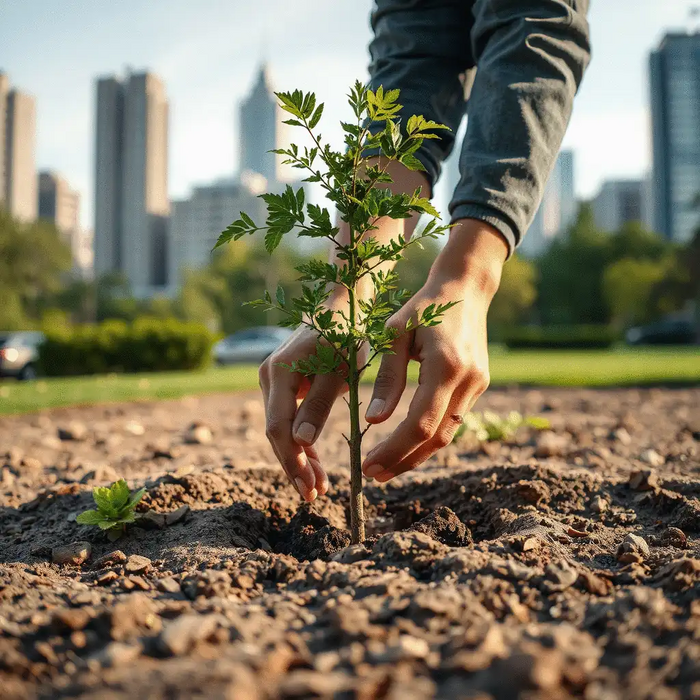Root Development
Stronger Roots
Trees planted in their ideal season develop stronger root systems.
Subscribe to get expert tips and the latest insights on tree care and urban greening directly to your inbox.
Posted on: 2025-06-26
By: Keira Vallejo
Understanding the key factors that influence the timing of tree planting is essential for successful urban forestry. Below is a visual representation illustrating the comparative effects of seasonal planting on root development, environmental stress, and growth rates.
Stronger Roots
Trees planted in their ideal season develop stronger root systems.
Reduced Stress
Proper timing helps trees avoid harsh weather conditions.
Enhanced Growth
Trees planted at the right time grow faster and healthier.
Have you ever wondered why some trees seem to thrive while others struggle? It often comes down to one crucial factor: timing! Planting trees at the right moment can significantly influence their growth and resilience in urban settings. At Urban Canopy Blog, we believe that understanding the nuances of tree planting seasons is essential for nurturing healthy city green spaces.
Each season brings unique conditions that can either bolster or hinder a tree’s growth. For instance, trees have specific climate requirements, and understanding these can guide you in selecting the best times to plant. By aligning your planting efforts with these seasonal characteristics, you lay the groundwork for robust growth, ensuring that your trees flourish for years to come.
Did you know that the season you choose to plant can impact root establishment and overall vitality? During the right season, trees are better equipped to absorb water and nutrients, which sets them up for success! The timing of planting often coincides with the natural growth cycles of trees. To ensure your trees get the care they deserve, consider the benefits of professional tree care.
Here are some key reasons why choosing the right season is essential:
At Urban Canopy Blog, we always emphasize the importance of these factors. Trees are living organisms that respond to their environment, and understanding the timing of their needs can lead to thriving urban forests.
When it comes to urban tree planting, several factors work together to determine success. From soil quality to local climate, each element plays a role in the health of our green companions. Recognizing these influences is critical for any urban forestry initiative.
Here are some key factors that can impact the success of your planting efforts:
Understanding these factors enables you to make informed decisions when planting trees in urban environments. With a little planning and knowledge, we can transform our cities into greener, more sustainable places!
Here's a brief recap of the key points discussed so far:
Understanding the right timing for planting trees in urban areas is crucial for their long-term health and resilience. I’ve seen firsthand how well-timed planting can lead to stronger, healthier trees that thrive in challenging environments. By planting during optimal seasons, we can give our urban trees the best chance to establish strong roots and adapt to their surroundings.
Adopting best practices in timing not only supports individual trees but also contributes to a more sustainable urban ecosystem. When we grasp the importance of timing, we can create greener, healthier cities for everyone. Remember, every tree planted at the right time can significantly improve our air quality, enhance aesthetics, and boost community well-being.
Proper timing plays a pivotal role in ensuring that urban trees not only survive but thrive. Trees planted in the right season develop robust root systems that help them access water and nutrients effectively. This resilience is essential when facing urban stressors like compacted soil and pollution.
When considering timing, here are some key impacts to keep in mind:
Here are some frequently asked questions about urban tree planting:
As I reflect on my experiences with urban tree care, I can’t stress enough the importance of following best practices. These practices include selecting the right time to plant, understanding your local climate, and choosing suitable tree species. With these considerations in mind, we can make a significant impact on our urban landscapes. For instance, understanding the climate can help you choose trees that will flourish.
Here are some best practices to remember:
Community involvement is vital for successful urban tree planting initiatives. When citizens participate in local tree projects, they help cultivate a sense of ownership and pride in their neighborhoods. At Urban Canopy blog, we believe that every individual can make a difference in enhancing urban greenery.
Getting involved can be as simple as participating in local events or educating oneself about tree care. Here are some ways you can contribute:
There are many avenues for community members to engage in urban tree planting efforts. From volunteering to sharing knowledge, every action counts! Here are some practical ways to get started:
To deepen your understanding of urban tree care, I recommend utilizing various resources available online and within your community. Educating yourself can empower you to take meaningful action for your local environment. Here are some useful resources to check out:
Engaging with public campaigns not only spreads knowledge but also fosters community connections. Here are some beneficial campaigns and programs to explore:
Remember, as we work together to nurture our urban trees, we are building a more vibrant and sustainable environment for future generations. So, let’s get involved and make our city greener, one tree at a time!
For more insights, check out our guide to soil quality for urban trees.
Here is a quick recap of the important points discussed in the article:

 In urban environments, trees are often the unsung heroes contributing to our well-being and the over
In urban environments, trees are often the unsung heroes contributing to our well-being and the over
 Urban trees are essential to our cities, yet they face numerous threats from pests and diseases. Did
Urban trees are essential to our cities, yet they face numerous threats from pests and diseases. Did
 Did you know that urban tree diversity is crucial not just for aesthetics, but for the health of ent
Did you know that urban tree diversity is crucial not just for aesthetics, but for the health of ent